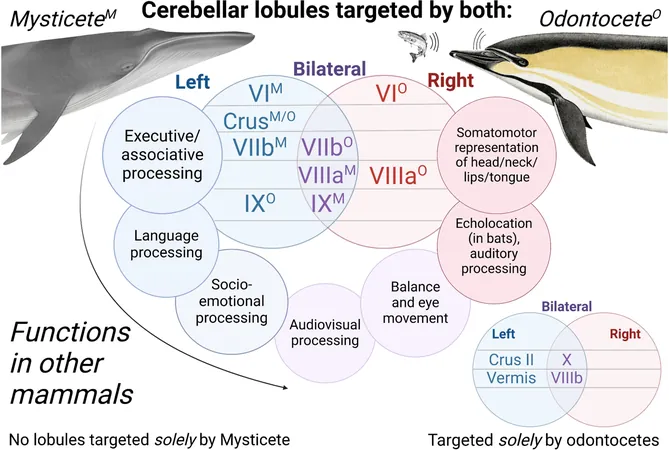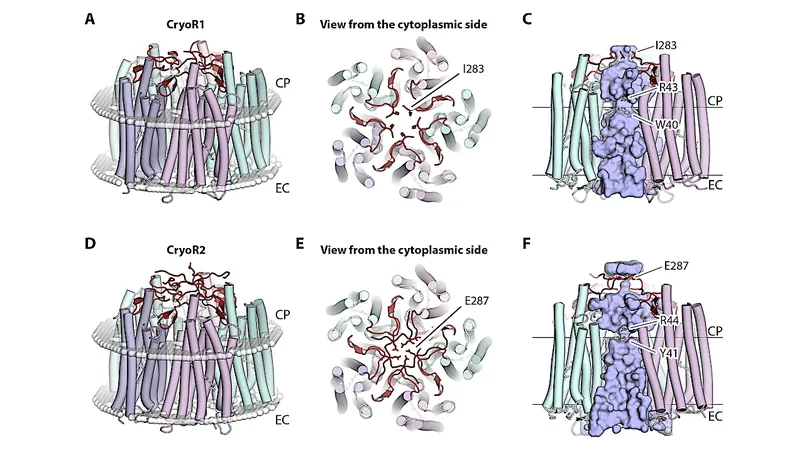
Unlocking the Secrets of Dolphin and Whale Echolocation: A Revolutionary Study
2025-06-09
Author: John Tan
Echolocation: Nature's Underwater Sonar System
Toothed whales, including dolphins, utilize sound as their primary navigational tool, helping them to locate objects and catch prey. They emit clicking noises, receiving the returning echoes to gather information about their surroundings. This unique ability, known as echolocation, is a fascinating rarity in the animal kingdom.
Groundbreaking Research Unveils Dolphin Brain Evolution
A groundbreaking study from experts at the Woods Hole Oceanographic Institution and several universities, including UC Berkeley and Oxford, published in *PLOS One*, dives deep into how dolphin brains have evolved to harness echolocation. By employing advanced techniques to map brain networks from the excised brains of stranded cetaceans, researchers compared the auditory pathways of echolocating dolphins to those of a non-echolocating sei whale.
Common Ancestry: The Diverging Paths of Whales and Dolphins
Despite sharing a common ancestor, dolphins and baleen whales have taken strikingly different evolutionary routes. While dolphins have honed their echolocation abilities, baleen whales have not. This comparative study marks a first-of-its-kind analysis of the brain networks between these two groups, shedding light on how evolution has sculpted dolphins’ echolocation ability—they literally 'touch' the world through sound.
Research Insights: A Window into Echolocation Pathways
Lead author Sophie Flem, a marine mammal master's student, emphasized the importance of discovering how auditory pathways differ between echolocating and non-echolocating species. While mental maps of brain functions exist for many land animals, this remains largely uncharted territory for dolphins, whose brains are remarkably distinct.
Uncovering Surprising Connections in the Dolphin Brain
Using the inferior colliculus—a key auditory structure—the researchers traced sound pathways deeper into the dolphins' brains. Surprisingly, despite dolphins having more cortical projection sites than sei whales, their auditory connections were not necessarily stronger. Instead, the dolphins exhibited enhanced pathways leading to the cerebellum, hinting at a complex integration of sensory information that aids in echolocation.
Echolocation: A Symphony of Sound and Movement
Explaining the mechanics of echolocation, Peter Tyack, co-author and marine biologist, likened the process to feeling one’s way in a dark room. Dolphins generate echolocation clicks, which they need to direct and focus, akin to guiding a hand to find a light switch. This process intricately weaves together hearing and vocalization, reflecting how dolphins interact with their murky environment.
Revolutionary Imaging Techniques Overcome Technical Challenges
The study faced significant challenges, especially in imaging the enormous brains. Traditional diffusion brain imaging produced subpar images. However, advancements developed by Karla Miller and Ben Inglis significantly enhanced image clarity, paving the way for this compelling research.
A New Era of Understanding Dolphin and Whale Brains
According to senior author Peter Cook, the analysis of dolphin and whale brain connections opens exciting doors for evolutionary biology. The research team aims to expand their study by examining more cetacean brains, particularly focusing on neural pathways for vocalization. With this groundbreaking understanding, researchers believe they can unravel the complexities of vocal control in dolphins, whose vocalization systems are among the most intricate in the animal kingdom.
Conclusion: The Journey of Discovery Continues
This innovative study not only highlights the extraordinary capabilities of dolphins but also serves as a springboard for future explorations into the neural networks of these remarkable creatures. As we continue to scan the depths of their brains, the mysteries of dolphin communication and echolocation seem to be just the beginning of an incredible journey.



 Brasil (PT)
Brasil (PT)
 Canada (EN)
Canada (EN)
 Chile (ES)
Chile (ES)
 Česko (CS)
Česko (CS)
 대한민국 (KO)
대한민국 (KO)
 España (ES)
España (ES)
 France (FR)
France (FR)
 Hong Kong (EN)
Hong Kong (EN)
 Italia (IT)
Italia (IT)
 日本 (JA)
日本 (JA)
 Magyarország (HU)
Magyarország (HU)
 Norge (NO)
Norge (NO)
 Polska (PL)
Polska (PL)
 Schweiz (DE)
Schweiz (DE)
 Singapore (EN)
Singapore (EN)
 Sverige (SV)
Sverige (SV)
 Suomi (FI)
Suomi (FI)
 Türkiye (TR)
Türkiye (TR)
 الإمارات العربية المتحدة (AR)
الإمارات العربية المتحدة (AR)